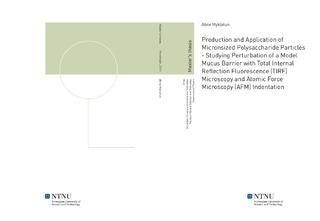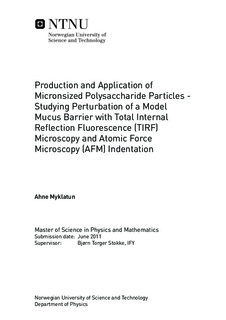| dc.description.abstract | The overall aim of this project was to produce homogeneously sized polysaccharide microparticles and apply these and similar sized particles as probes for investigation of mucin layers as a model for a biological barrier. Small polysaccharide particles have many applications, e.g. within the medical field of drug delivery. In this study a microfluidic system was developed to produce alginate beads, which can be used in drug delivery systems. Different designs, continuous phases and concentrations were tested in order to find an optimal system. Beads in the size range of 10 µm were produced using a device with T-shaped design and three inlets. An electrostatic bead generator was also used to make alginate beads, however the beads produced were too large to be used in the experiments with the mucin layers.One of the many challenges when working with drug delivery systems is the mucus barrier protecting the epithelial cells. In this study a model mucus barrier was made by immobilizing mucins, the glycoprotein responsible for the physical properties of the barrier. A procedure for fluorescence labelling of polystyrene beads with quantum dots was developed, and penetration of these beads into the model barrier was measured with total internal reflection fluorescence (TIRF) microscopy. In TIRF the excitation field intensity decays exponentially, and the emitted fluorescence intensity from the beads gives an indication of the distance between the beads and the surface. Measurements performed on mucin layers of different concentrations indicate that mucin concentrations above 0,5 mg/ml will result in a layer too thick or too dense to give a intensity signal. At mucin concentration 0,05 mg/ml fluorescence was observable in TIRF, and it was clearly weaker than for the control with a bead directly on a glass surface. This indicates that the beads hover over the surface due to the mucin layers, and show that it is in principle possible to measure the penetration depth of beads into mucin layer using TIRF. To simulate the condition in the lungs of cystic fibrosis (CF) patients, the mucin layers were incubated with alginate. Measurements were performed to see how this affected the penetration of the beads into the layer. A weaker fluorescent signal was obtained for these samples in TIRF, which suggests that there has been interaction between mucin and alginate. It was in addition investigated how different concentrations of G-blocks in the solution affected the penetration into the mucin-alginate layer. These testes were carried out using both TIRF and atomic force microscopy (AFM) nanoindentation experiments. The TIRF measurements were inconclusive, while the nanoindentation experiments showed decreased interaction between mucin-alginate layer and a bead. | nb_NO |

